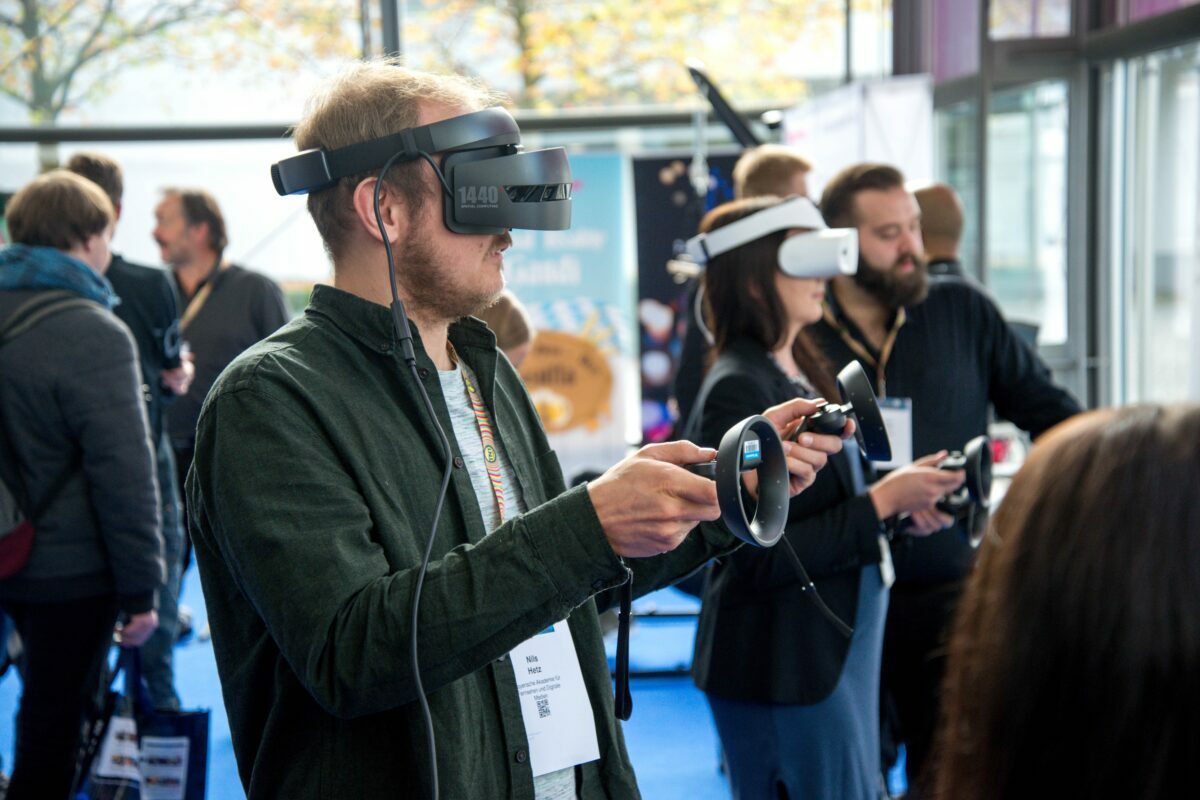As businesses continue to explore the metaverse, many are finding new and innovative ways to take advantage of the digital space. The McKinsey & Company report released in June estimates that the metaverse could generate up to $5 trillion in value by 2030. That’s a huge opportunity for businesses to tap into.
As the metaverse continues to grow in popularity, so does the need for businesses to create engaging and immersive experiences for their customers. This is where visual storytelling comes in.
As marketers, we know the importance of storytelling. It’s a powerful way to connect with our audience and generate interest in our products or services. But what about when that story is extended into virtual space?
The rise of virtual reality and metaverse platforms offers a whole new world of opportunities to tell our stories in creative and engaging ways. With the potential to reach a global audience, visual storytelling in the metaverse can be an extremely effective content marketing tool.
With the right strategy, businesses can use visual storytelling to create stunning and memorable experiences for their customers. So how can you get started?
In this blog post, we will explore the power of visual storytelling in the metaverse and how businesses can create immersive experiences for their customers.
What is the Metaverse?
The term “metaverse” was coined by science fiction writer Neal Stephenson in his 1992 novel Snow Crash. It refers to a virtual world that is filled with user-generated content, where people can interact with each other in real time.
Today, the term is used to describe the growing trend of social interaction and content creation within online virtual worlds. The metaverse has been likened to a web-based version of reality, where users can interact with each other and with digital objects in a three-dimensional space.
While the concept of the metaverse has been around for decades, it is only recently that we have begun to see its potential. One company that is leading the charge in this area is Facebook (Meta). The social media giant has created a virtual world called Meta Horizon, which allows users to create their own avatars and explore digital spaces.
In addition, Facebook has also acquired Oculus VR, which will enable the company to create even more immersive experiences. With its vast resources and technological expertise, Facebook is well-positioned to become a major player in the metaverse.
Though the metaverse is still in its early stages of development, it holds great promise for the future of online communication and collaboration. With the rapid growth of virtual reality technology, it is likely that the metaverse will become an increasingly important part of our lives in the years to come.
The rise of visual storytelling in the metaverse
Visual storytelling is a way of communicating a story using images, videos, and other visual elements. It is an effective way to engage your audience and generate interest in your product or service.
In the past decade, we’ve seen a surge in the popularity of visual storytelling. Platforms like Instagram and Snapchat have made it easy for people to share photos and videos, and our attention spans have shortened, making it easier to consume bite-sized content.
At the same time, we’ve seen the rise of the metaverse – a digital world that exists beyond our physical one. In the metaverse, people can create avatars and interact with each other and with digital objects in a three-dimensional space.
When used in the metaverse, visual storytelling can be an even more powerful tool. Businesses can now use visual storytelling to create stunning and realistic environments that allow customers to explore and interact with their products in a new way.
Some businesses are already using the metaverse to create immersive experiences for their customers. Nike, for example, has created Nikeland, a metaverse space where people can explore and interact as avatars of themselves.
Nikeland is the place for Nike fans to connect with each other and with the brand. The metaverse space is open to everyone, and Nike hosts a variety of events and activities within it. In addition to being a place to hang out and meet new people, Nikeland also offer fans the chance to win prizes, participate in challenges and learn more about the brand.
For Nike, the metaverse provides an opportunity to build deeper relationships with its customers and create new experiences that are not possible in the physical world.
Another example comes from an automotive manufacturing giant Hyundai. The company’s recent launch of Hyundai Mobility Adventure, a metaverse space on Roblox, is a first-of-its-kind move that allows users to explore Hyundai Motor’s products and future mobility solutions, customize their avatars, and meet other fans.
The launch of Hyundai Mobility Adventure is targeted at young consumers who are technologically savvy and already familiar with virtual worlds. By providing this experience, Hyundai Motor Company is able to nurture long-lasting relationships with fans and introduce its products in a fun and interactive way.
These are just a few examples of how businesses are using the metaverse to create immersive experiences for their customers. As more people spend time in the metaverse and businesses continue to invest in the metaverse, we can expect to see even more creative uses of visual storytelling in this digital world.
How businesses can use the metaverse for visual storytelling
In a world where businesses increasingly rely on digital tools to reach their audiences, the metaverse provides a unique opportunity for businesses to create visual storytelling experiences that can engage and immerse their audiences in new ways.
The metaverse is a digital world that exists parallel to our own, and it is home to a growing number of virtual reality experiences. While businesses have traditionally used the internet to create static websites and digital marketing campaigns, the metaverse offers a dynamic and interactive platform that can take visual storytelling to the next level.
Here are some examples of how businesses can use the metaverse for visual storytelling:
1. Use virtual reality to create immersive experiences: Immersive experiences are the future of storytelling, and virtual reality is the perfect medium to create them. Using VR, you can transport your audience to another world, and let them explore it at their own pace. This gives them a sense of ownership over the story and allows them to discover its secrets for themselves.
What’s more, VR allows you to create truly interactive experiences. Your audience can choose how they want to experience the story, and you can design different paths for them to take. This freedom of choice ensures that every viewer will have a unique experience and that they’ll remember your story for years to come. So if you’re looking to create an immersive experience for your audience, virtual reality is the way to go.
2. Use 3D environments to bring products to life: As we all become more accustomed to living in a digital world, it’s important to find new ways to engage with potential customers. One way to do this is by using 3D environments to bring products to life. This can be a great way to add an extra dimension of interactivity and excitement to your product launch or marketing campaign.
By using 3D environments, you can give customers a chance to explore your product from all angles and get a feel for how it works. You can also use this opportunity to tell your brand’s story in a more immersive way. In the metaverse, anything is possible, so take advantage of this unique platform to really make your products come alive.
3. Use animated characters and avatars to engage with customers: As businesses increasingly move into the metaverse, they are looking for ways to engage with customers in this new environment. One of the most effective ways to do this is by using animated characters and avatars.
By using animated characters and avatars, businesses can create a more engaging and interactive experience for their customers. Avatars can be used to represent employees, providing a face and personality for customers to interact with. Characters can also be used to guide customers through digital space or to provide information and assistance. And because they are not bound by the physical laws of the real world, they can do things that would be impossible in the real world, making them ideal for demonstrating products or services.
Businesses that use animated characters and avatars in the metaverse are finding that it is an effective way to engage with customers and create a more immersive experience. As the metaverse continues to grow, we expect to see more and more businesses using this approach to connect with their customers.
4. Use augmented reality to blend the physical and digital worlds: The use of augmented reality is becoming more widespread as technology advances. AR allows users to superimpose digital content on top of the real world, creating an immersive experience that blurs the line between physical and virtual reality. This has potential implications for storytelling, as it opens up new ways to create and experience narrative.
For example, AR could be used to create interactive 3D stories that can be experienced in different ways depending on the user’s location. Additionally, AR could be used to bring characters to life in physical spaces or to create virtual environments that react to the user’s movements. The possibilities are endless, and augmented reality is poised to change the way we experience storytelling forever.
5. Use data visualizations to tell stories with data: In the metaverse, storytelling with data is a key to engaging with your audience and communicating your message effectively. Data visualizations can help you communicate complex ideas in a way that is easy for people to understand. They can also help you tell stories that would be difficult to tell with just words.
By using different types of visualizations, you can highlight different aspects of your data and tell a more complete story. And with the advent of the metaverse, data visualizations are only going to become more important. So get creative and start telling stories with your data today.
Conclusion
As businesses increasingly move into the metaverse, visual storytelling is becoming an important way to engage with customers and communicate messages effectively. With the ability to create immersive, interactive worlds, the metaverse provides endless possibilities for new and innovative ways to tell stories. The use of 3D environments, avatars, augmented reality, and virtual reality is just some of the ways that businesses are using to tell their stories in this new digital space.
In the coming years, we can expect to see more and more businesses and organizations using the metaverse as a platform for marketing, advertising, and even education. As the metaverse becomes increasingly popular, visual storytelling will become an increasingly important tool for engaging audiences and conveying information.
With its unlimited potential, the future of visual storytelling in the metaverse is truly limitless. So get ahead of the curve and start telling your stories in the metaverse today.




